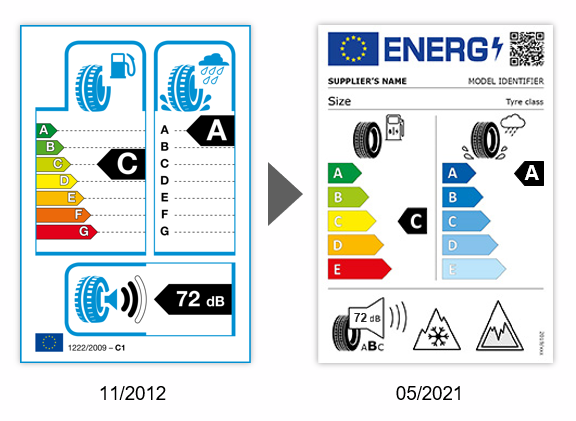Understanding The EU Label
Tyre Labelling
The Tyre Label is a mark for motor vehicle tyres. Manufacturers of tyres for cars, light and heavy trucks must specify fuel consumption, wet grip and noise classification of every tyre sold in EU market starting in November 2012. For passenger car, light truck and truck tyres the information must be available in technical promotional literature (leaflets, brochures, etc.), including the manufacturer website For passenger and light truck tyres, the manufacturers or importers have the choice of either putting a sticker on the tyre tread or a label accompanying each delivery of batch of tyres to the dealer and to the end consumer The tyre label will use a classification from the best (green category “A”) to the worst performance (red category “G”).
This initiative results from a regulation by the EU Commission released in 2009. It is part of the Energy Efficiency Action Plan, designed to improve the energy performance of products, buildings and services to reduce energy consumption by 20% until 2020. The EU has already created a system for marking of electrical household appliances such as refrigerators, washing machines and televisions with the intent to inform the European population better about the level of their consumption.

Rolling Resistance/ Fuel Efficiency
Rolling Resistance is a force acting opposite to the travel direction when the tyre is rolling.
Considering that tyres contribute up to 20% of the overall fuel consumption for a car and up to 35% for a truck, it is important to reach low Rolling Resistance values.
Let’s understand how it works: due to the vehicle load, the tyre is deformed in the contact area with the road surface dissipating energy in form of heat. The higher deformations, the higher the rolling resistance and consequently more fuel consumption and CO2 emissions.
In the EU tyre Regulation label, rolling resistance is expressed in grades, ranging from A (best grading) to F for industrial vehicles and G for cars (worst grading).
The difference between each grade means a reduction or increase in fuel consumption of between 2.5% – 4.5% for a car and 5%-8% for a Truck. For a car that could be also roughly expressed in terms of 0.1l/100km.

Wet Grip
Wet grip is one of the most important safety characteristic of a tyre. Excellent grip on wet means shorter braking distances when driving in rainy weather.
There are other important parameters which are relevant for safety but wet grip was chosen as the most representative situation in order to compare different tyres.
For a car the difference between each grade means an increase or decrease in stopping distance of roughly 3 and 6 meters when braking from 80km/h.

Noise
Traffic noise is a relevant environmental issue determined by several factors such as:
* Traffic intensity
* Vehicle type
* Driving style
* Tyre-Road interaction
The value indicated in the label is not the internal that the driver will perceive while driving, but the external one, that is contributing to acoustic pollution.
It is expressed in decibel (dB) and split in 3 categories:
* 1 black sound wave = 3dB less than the future tighter European limit.
* 2 black sound waves = already compliant with the future European limit.
* 3 black sound waves = compliant with the current European limit.
The more black bars shown on the label, the louder the tyre.

